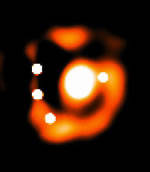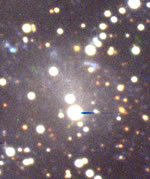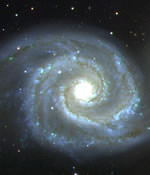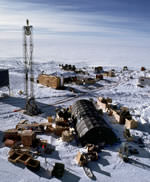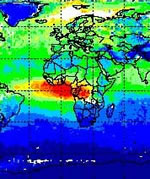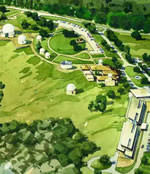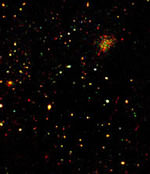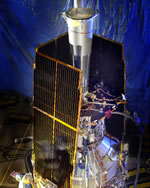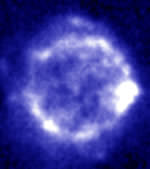
Image credit: Hubble
A new article published in the journal Nature helps settle a long-time mystery about some of the earliest solid particles in the Universe. By measuring supernova remnant Cassiopeia A with the very precise SCUBA telescope, astronomers were able to detect enormous quantities of cosmic dust below -257 degrees Celsius. Hot dust had been found in the past, but the colder dust was mostly invisible – until now. It appears that supernovae are extremely efficient at producing the dust that later forms planets, rocks, and people.
We have just discovered that some supernovae have bad habits – they belch out huge quantities of smoke, known as cosmic dust. This solves a long-standing mystery over the origin of cosmic dust and suggests that supernovae, which are exploding stars, were responsible for producing the first ever solid particles in the Universe.
The Prime Suspects
Supernovae are the violent explosions of stars occurring at the end of their lives. They occur around every 50 years or so in our Galaxy and there are two main types – Type Ia and II. Type II are the explosions of very massive stars with mass greater than 8 times the mass of the Sun (Msun). These stars are ‘live fast – die young’ using up their hydrogen and helium fuel in only a few million years, thousands of times faster than the Sun burns it’s fuel. When the fuel supply is exhausted the star must burn heavier and heavier elements until, finally, when it can do no more to keep itself alive the inner parts of the star collapse to form a neutron star or Black Hole, and the outer parts are flung off in the cataclysm we call a supernova. The enormous explosion sweeps up the surrounding gas into a shell which shines at X-ray, optical and radio wavelengths, and sends shock waves through the galaxy. Supernovae release more energy in a single instant than the Sun will produce in its whole life-time. If the nearest massive star, Betelgeuse in the constellation Orion, were to go supernova it would (for a short time) be brighter than the full moon.
The Cosmic Smoke-Screen
Interstellar dust consists of tiny particles of solid material floating around in the space between the stars – with sizes typically that of cigarette smoke. It is not the same as the dust we clean up in our houses, and in fact the Earth is a giant lump of cosmic dust! It is responsible for blocking about half of all the light emitted from stars and galaxies and profoundly affects our view of the Universe. This ‘dusty’ cloud has a silver lining though, as the astronomers can `see’ the dust radiating the stolen starlight using special cameras designed to work at longer wavelengths, in the Infra-Red (IR: 10 – 100 microns) and Submillimeter (sub-mm: 0.3 – 1mm) part of the electromagnetic spectrum. One such camera is called SCUBA and it is located on the James Clerk Maxwell Telescope in Hawaii. SCUBA is a UK-built instrument which detects light-waves at sub-mm wavelengths and is able to see dust right out to where the furthest stars and galaxies are found.
Dusty Beginnings
Recent observations with SCUBA have shown that a huge amount of dust exists in galaxies and quasars when the Universe was only 1/10th of its present age, long before the Earth and solar system had formed. The presence of all this dust in the distant Universe has a great impact on what astronomers are able to see with their giant optical telescopes, as it limits the amount of starlight which can escape from a distant galaxy and be seen on Earth.
That there were so many solid particles in Universe at such an early time was a great surprise to astronomers as they had believed that dust was mainly formed in cool winds from red giant stars near the end of their lives. Since it takes a long time for star to reach this stage in its evolution (the Sun will take around 9 billion years) there has simply not been enough time for so much dust to have been made in this way.
‘Dust has been swept under the cosmic carpet – for years astronomers have treated it as a nuisance because of the way it hides the light from the stars. But then we found that there is dust right at the edge of the Universe, in the earliest stars and galaxies, and we realised that we were ignorant of even its basic origin’ explained Dr Dunne.
Supernovae also make large amounts of heavy elements, such as carbon and oxygen, and throw them out into interstellar space. These are the elements which make up our bodies and, since they are also the elements which make up dust grains, supernovae have long been a prime suspect in the mystery of the origin of cosmic dust. As it takes only a few million years for the most massive stars to reach the end of lives and explode as supernovae, they could make dust quickly enough to explain what is seen in the early Universe. However, until this team’s work, only tiny amounts of dust had ever been found in supernovae – leaving astronomers with a smoking gun but no ‘smoke’
Haley Morgan, a PhD student at Cardiff said ‘If supernovae were efficient dust ‘factories’ they would each be producing more than the mass of the Sun in dust.’
‘As massive stars evolve to become supernovae in the blink of an eye by astronomical standards, they could easily explain why the early Universe appears so dusty.’ added Dr Rob Ivison of the Royal Observatory Edinburgh.
Supernova Sleuths
The team from Cardiff and Edinburgh used SCUBA to look for the emission from dust in the remains of a recent supernova. Cassiopeia A is the remnant of a supernova which happened around 320 years ago. It is located in the constellation Cassiopeia, 11,000 light years from Earth and is about 10 light years across. Cas A is the brightest radio source in the sky so it is well studied at many wavelengths from the optical to X-rays. The images below show Cas A in the X-rays, optical, infra-red and radio. The X-rays follow the really hot gas (10 million degrees Kelvin), and the other wavelengths trace material at: 10 thousand degrees (optical), hot dust at 100 K (IR) and high energy electrons (radio).
Although astronomers had been searching for dust in supernova remnants for decades, they had used instruments which could only detect dust that was quite warm, such as that in the ISO infra-red image above. SCUBA has the advantage here because it is able to see dust which is very cold and this is because it works at longer sub-mm wavelengths.
‘In the same way that you can only see an iron poker glowing when it’s been in a fire, you can only see dust with infra-red cameras when it is warmer than about 25 Kelvin, but SCUBA can see it when it’s colder too’ explained Dr Steve Eales, Reader in Astrophysics at Cardiff University.
Cold Hard Evidence
SCUBA found a large amount of dust in the Cas A remnant, 1-4 times more than the mass of the Sun ! This is over 1,000 times more than had been seen before. This means that Cas A was very efficient at creating dust from the elements available. The temperature of the dust is very low, only 18 Kelvin (-257 degrees Celsius), and this is the reason that it had never been seen before. Below are the two sub-mm images of Cas A at 850 and 450 microns taken with SCUBA. You can see that the left image looks a little like the radio one above, and this is because the high energy electrons which make the radio image also emit some of their energy at slightly shorter wavelengths – contaminating the sub mm emission at 850microns. The middle image is at 450 microns where the contamination is much lower, and so most of this emission is from cold dust. If we remove the contamination we get a different picture (right). All the dust is seen in the bottom half of the remnant and the two sub-mm images now look much more similar!
850 microns without radio contamination
‘The puzzle is how the dust can remain so cold when we know that there is gas at over a million degrees present from the X-ray radiation it gives off.’ commented Prof. Mike Edmunds, head of the School of Physics & Astronomy in Cardiff.
The dust also has different properties to the ‘everyday’ kind of dust in the Milky Way and other galaxies – it is better at ‘shining’ in the sub-mm, maybe because it is still very young and relatively pristine. If all supernovae were this efficient at making dust they would be the biggest dust ‘factories’ in the Galaxy. Smoking supernovae provide a solution to the mystery of the huge amounts of dust seen in the early Universe.
‘These observations give us a tantalising glimpse of how the first solid particles in the Universe were created’ said Haley Morgan.
Original Source: Cardiff University News Release

